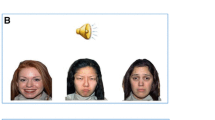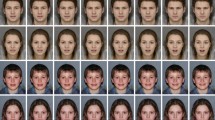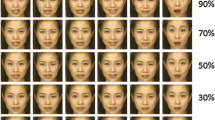Abstract
We investigated the recognition of pairs of faces (same or different facial identities and expressions) in two groups of 14 children aged 6–10 years, with either an expressive language disorder (ELD), or a mixed language disorder (MLD), and two groups of 14 matched healthy controls. When looking at their global performances, children with either expressive (ELD) or MLD have few differences from controls in either face or emotional recognition. At contrary, we found that children with MLD, but not those with ELD, take identical faces to be different if their expressions change. Since children with mixed language disorders are socially more impaired than children with ELD, we think that these features may partly underpin the social difficulties of these children.

Similar content being viewed by others
References
American Psychiatric Association (1994) Diagnostic and statistical manual of mental disorders, 4th edn. American Psychiatric association, Washington, DC
Beitchman JH, Wilson B, Brownlie EB, Walters H, Inglis A, Lancee W (1996) Long-term consistency in speech/language profiles: II. Behavioral, emotional, and social outcomes. J Am Acad Child Adolesc Psychiatry 35(6):815–825
De Haan M, Nelson A (1998) Discrimination and categorisation of facial expressions of emotion during infancy. In: Slater A (ed) Perceptual Development: visual, auditory, and speech perception in infancy. Psychology Press, Taylor and Francis Group. pp 287–309
Dupont H, Gardner OS, Brody SS (1979) Towards affective development, instructional material. American Guidance Service, Circle Pines, MN
Fox CJ, Barton JJS (2007) What is adapted in face adaptation? The neural representations of expression in the human visual system. Brain Res 1127:80–89
Gauger LM, Lombardino LJ, Leonard CMB (1997) Brain morphology in children with specific language impairment. J Speech Lang Hear Res 40(6):1272–1284
Haxby VH, Hoffman EA, Gobbini I (2000) The distributed human neural system for face perception. Trends Cogn Sci 4(6):223–233
Herbert MR, Ziegler DA, Deutsch CK, O’Brien LM, Kennedy DN, Filipek PA, Bakardjiev AI, Hodgson J, Takeoka M, Makris N, Caviness VS Jr (2005) Brain asymmetries in autism and developmental language disorder: a nested whole-brain analysis. Brain 128:213–226
Hobson RP, Ouston J, Lee A (1988b) What’s in a face? The case of autism. Br J Psychol 79:441–453
Hobson RP (1991) Methodological issues for experiments on autistic individuals’ perception and understanding of emotion. J Child Psychol Psychiatry 32(7):1135–1158
Hoffman EA, Haxby VH (2000) Distinct representations of eye gaze and identity in the distributed human neural system for face perception. Nat Neurosci 3 (1):80–84
Lai Z (1992) A neuropsychological test of cortical circuitry subserving affective processing in the developing human brain. Unpublished doctoral dissertation, University of Minneapolis, Minneapolis
Lord C, Pickles A (1996) Language level and non-verbal social-communicative behaviours in autistic and language-delayed children. J Am Acad Child Adolesc Psychiatry 35(11):1542–1550
Mawhood L, Howlin P, Rutter M (2000) Autism and developmental receptive language disorder—a comparative follow-up in early adult life. I Cognitive and language outcomes. J Child Psychol Psychiatry 41(5):547–559
O’Toole AJ, Roark DA, Abdi H (2002) Recognizing moving faces: a psychological and neural synthesis. Trends Cogn Sci 6(6):261–266
Ozonoff S, Pennington BF, Rogers SJ (1990) Are there emotion perception deficits in young children with autism? J Child Psychol Psychiatry 31:343–61
Pascalis O, de Schonen S (1994) Recognition memory in 3-to-4-day-old human neonates. Neuroreport 8 5(14):1721–1724
Paul R, Cohen DJ, Caramulo BK (1983) A longitudinal study of patients with severe developmental disorders of language learning. J Am Acad Child Adolesc Psychiatry 22(6):525–534
Robel L, Ennouri K, Piana H, Vaivre-Douret L, Perier A, Flament M, Mouren-Siméoni M-C (2004) Discrimination of face identities and expressions in children with autism: same or different? Eur J Child Adolesc Psychiatry 13:227–233
Shapiro EG, Hugues JG, August GJ, Bloomquist ML (1993) Processing of emotional information in children with attention-deficit hyperactivity disorder. Dev Neuropsychol 9:207–224
Toppelberg CO, Shapiro T (2000) Language disorders: a 10-year research update review. J Am Acad Child Adol Psychiatry 39:143–152
Author information
Authors and Affiliations
Corresponding author
Additional information
We thank S. Hugues and E. Shapiro for providing us with the MNTAP. We thank the children and their parents, for their participation to the study. This work was supported by the “Fondation de France”.
Rights and permissions
About this article
Cite this article
Robel, L., Vaivre-Douret, L., Neveu, X. et al. Children with mixed language disorder do not discriminate accurately facial identity when expressions change. Eur Child Adolesc Psychiatry 17, 507–515 (2008). https://doi.org/10.1007/s00787-008-0694-8
Accepted:
Published:
Issue Date:
DOI: https://doi.org/10.1007/s00787-008-0694-8




